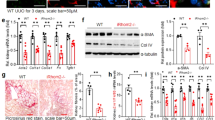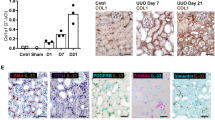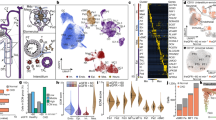Abstract
The functional contribution of myofibroblasts in fibrosis is not well understood1,2,3. Using a new genetic mouse model to track and isolate myofibroblasts, we performed gene expression profiling followed by biological validation to identify HE4 (encoding human epididymis protein 4, also known as WAP 4-disulfide core domain-2 or Wfdc2) as the most upregulated gene in fibrosis-associated myofibroblasts. The HE4 gene encodes for a putative serine protease inhibitor that is upregulated in human and mouse fibrotic kidneys and is elevated in the serum of patients with kidney fibrosis. HE4 suppresses the activity of multiple proteases, including serine proteases and matrix metalloproteinases, and specifically inhibits their capacity to degrade type I collagen. In particular, we identified two serine proteases, Prss35 and Prss23, as HE4 targets with functional relevance in kidney fibrosis. Administration of HE4-neutralizing antibodies accelerated collagen I degradation and inhibited fibrosis in three different mouse models of renal disease. Collectively these studies suggest that HE4 is a potential biomarker of renal fibrosis and a new therapeutic target.
This is a preview of subscription content, access via your institution
Access options
Subscribe to this journal
Receive 12 print issues and online access
$209.00 per year
only $17.42 per issue
Buy this article
- Purchase on Springer Link
- Instant access to full article PDF
Prices may be subject to local taxes which are calculated during checkout




Similar content being viewed by others
References
Zeisberg, M., Strutz, F. & Muller, G.A. Role of fibroblast activation in inducing interstitial fibrosis. J. Nephrol. 13 (suppl. 3), S111–S120 (2000).
Eddy, A.A. Molecular insights into renal interstitial fibrosis. J. Am. Soc. Nephrol. 7, 2495–2508 (1996).
Strutz, F. & Muller, G.A. Renal fibrosis and the origin of the renal fibroblast. Nephrol. Dial. Transplant. 21, 3368–3370 (2006).
Okada, H., Strutz, F., Danoff, T.M., Kalluri, R. & Neilson, E.G. Possible mechanisms of renal fibrosis. Contrib. Nephrol. 118, 147–154 (1996).
Zeisberg, M. & Neilson, E.G. Mechanisms of tubulointerstitial fibrosis. J. Am. Soc. Nephrol. 21, 1819–1834 (2010).
Meran, S. & Steadman, R. Fibroblasts and myofibroblasts in renal fibrosis. Int. J. Exp. Pathol. 92, 158–167 (2011).
Barnes, J.L. & Glass, W.F. II. Renal interstitial fibrosis: a critical evaluation of the origin of myofibroblasts. Contrib. Nephrol. 169, 73–93 (2011).
Grgic, I., Duffield, J.S. & Humphreys, B.D. The origin of interstitial myofibroblasts in chronic kidney disease. Pediatr. Nephrol. 27, 183–193 (2012).
Kirchhoff, C. Molecular characterization of epididymal proteins. Rev. Reprod. 3, 86–95 (1998).
Kirchhoff, C., Habben, I., Ivell, R. & Krull, N. A major human epididymis-specific cDNA encodes a protein with sequence homology to extracellular proteinase inhibitors. Biol. Reprod. 45, 350–357 (1991).
Hahm, K. et al. Alphav beta6 integrin regulates renal fibrosis and inflammation in Alport mouse. Am. J. Pathol. 170, 110–125 (2007).
Zhang, G. et al. Urokinase receptor deficiency accelerates renal fibrosis in obstructive nephropathy. J. Am. Soc. Nephrol. 14, 1254–1271 (2003).
Bingle, L., Singleton, V. & Bingle, C.D. The putative ovarian tumour marker gene HE4 (WFDC2), is expressed in normal tissues and undergoes complex alternative splicing to yield multiple protein isoforms. Oncogene 21, 2768–2773 (2002).
Clauss, A., Lilja, H. & Lundwall, A. A locus on human chromosome 20 contains several genes expressing protease inhibitor domains with homology to whey acidic protein. Biochem. J. 368, 233–242 (2002).
Clauss, A., Lilja, H. & Lundwall, A. The evolution of a genetic locus encoding small serine proteinase inhibitors. Biochem. Biophys. Res. Commun. 333, 383–389 (2005).
Bingle, L. et al. WFDC2 (HE4): a potential role in the innate immunity of the oral cavity and respiratory tract and the development of adenocarcinomas of the lung. Respir. Res. 7, 61 (2006).
Greer, K.A. et al. Gene expression analysis in a canine model of X-linked Alport syndrome. Mamm. Genome 17, 976–990 (2006).
Bielesz, B. et al. Epithelial Notch signaling regulates interstitial fibrosis development in the kidneys of mice and humans. J. Clin. Invest. 120, 4040–4054 (2010).
Bunnag, S.a. Molecular correlates of renal functions in kidney transplant biopsies. J. Am. Soc. Nephrol. 20, 1149–1160 (2009).
Galgano, M.T., Hampton, G.M. & Frierson, H.F. Jr. Comprehensive analysis of HE4 expression in normal and malignant human tissues. Mod. Pathol. 19, 847–853 (2006).
Sivashanmugam, P. et al. Characterization of mouse Eppin and a gene cluster of similar protease inhibitors on mouse chromosome 2. Gene 312, 125–134 (2003).
Bignotti, E. et al. Diagnostic and prognostic impact of serum HE4 detection in endometrial carcinoma patients. Br. J. Cancer 104, 1418–1425 (2011).
Drapkin, R. et al. Human epididymis protein 4 (HE4) is a secreted glycoprotein that is overexpressed by serous and endometrioid ovarian carcinomas. Cancer Res. 65, 2162–2169 (2005).
Matsuo, S. et al. Multifunctionality of PAI-1 in fibrogenesis: evidence from obstructive nephropathy in PAI-1-overexpressing mice. Kidney Int. 67, 2221–2238 (2005).
Oda, T. et al. PAI-1 deficiency attenuates the fibrogenic response to ureteral obstruction. Kidney Int. 60, 587–596 (2001).
Catania, J.M., Chen, G. & Parrish, A.R. Role of matrix metalloproteinases in renal pathophysiologies. Am. J. Physiol. Renal Physiol. 292, F905–F911 (2007).
Zeisberg, M. et al. Bone morphogenic protein-7 inhibits progression of chronic renal fibrosis associated with two genetic mouse models. Am J. Physiol. Renal Physiol. 285, F1060–F1067 (2003).
Bechtel, W. et al. Methylation determines fibroblast activation and fibrogenesis in the kidney. Nat. Med. 16, 544–550 (2010).
Panicker, L.M., Usha, R., Roy, S. & Mandal, C. Purification and characterization of a serine protease (CESP) from mature coconut endosperm. BMC Res. Notes 2, 81 (2009).
LeBleu, V.S., Sugimoto, H., Miller, C.A., Gattone, V.H. II & Kalluri, R. Lymphocytes are Dispensable for Glomerulonephritis but Required for Renal Interstitial Fibrosis in Matrix Defect Induced Alport Renal Disease. Lab. Invest. 88, 284–292 (2008).
Lebleu, V.S. et al. Stem Cell Therapies Benefit Alport Syndrome. J. Am. Soc. Nephrol. 20, 2359–2370 (2009).
Sugimoto, H. et al. Activin-like kinase 3 is important for kidney regeneration and reversal of fibrosis. Nat. Med. 18, 396–404 (2012).
Acknowledgements
This study was supported by US National Institutes of Health (NIH) grants DK55001, DK081976, CA125550, CA155370, CA151925 and CA163191, funding from the Harvard Stem Cell Institute, the Metastasis Research Center at the MD Anderson Cancer Center and the Cancer Prevention and Research Institute of Texas (all to R.K.). V.S.L. was funded from the NIH Research Training grant in Gastroenterology (2T32DK007760-11), H.S. was funded by the NIH Research Training grant in Cardiovascular Biology (5T32HL007374-30), and J.T.O. was funded by the NIH Cell and Development Biology Training grant GM07226 and the Department of Defense Breast Cancer Predoctoral Traineeship Award BC083229.
Author information
Authors and Affiliations
Contributions
R.K. provided intellectual input and the conceptual framework, designed the study and helped in the writing of the manuscript. V.S.L. designed the study, provided intellectual input, performed experiments, collected data and wrote the manuscript. Y.T., J.T.O. and H.S. performed some experiments and collected data. D.C., G.A.M. and C.A.M. provided human samples for analysis.
Corresponding author
Ethics declarations
Competing interests
The authors declare no competing financial interests.
Supplementary information
Supplementary Text and Figures
Supplementary Tables 1 and 2, Supplementary Methods and Supplementary Figures 1–5 (PDF 9323 kb)
Rights and permissions
About this article
Cite this article
LeBleu, V., Teng, Y., O'Connell, J. et al. Identification of human epididymis protein-4 as a fibroblast-derived mediator of fibrosis. Nat Med 19, 227–231 (2013). https://doi.org/10.1038/nm.2989
Received:
Accepted:
Published:
Issue Date:
DOI: https://doi.org/10.1038/nm.2989
This article is cited by
-
Proteomics of CKD progression in the chronic renal insufficiency cohort
Nature Communications (2023)
-
Autocrine TGF-β-positive feedback in profibrotic AT2-lineage cells plays a crucial role in non-inflammatory lung fibrogenesis
Nature Communications (2023)
-
A small molecule 20C from Gastrodia elata inhibits α-synuclein aggregation and prevents progression of Parkinson’s disease
Cell Death & Disease (2023)
-
Silencing HE4 alleviates the renal fibrosis in lupus nephritis mice by regulating the C3/MMPs/prss axis
Naunyn-Schmiedeberg's Archives of Pharmacology (2023)
-
Sodium–glucose cotransporter inhibitors and kidney fibrosis: review of the current evidence and related mechanisms
Pharmacological Reports (2023)



